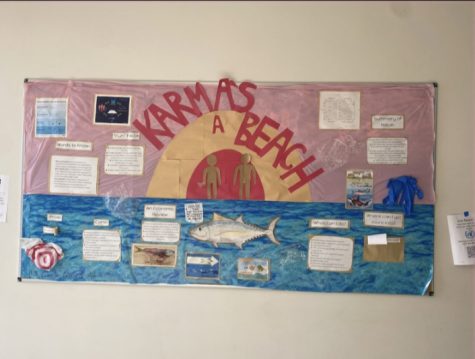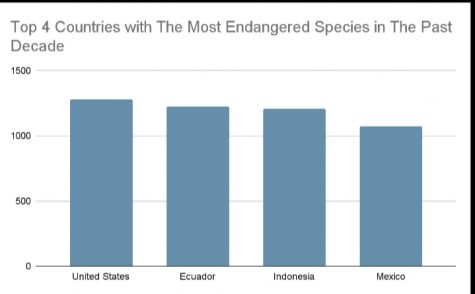The Brink of Animal Extinction
Global warming is a common catch phrase for a serious set of topics, including the sixth great extinction. This destruction of species began around a 100 years back as a consequence of deforestation, poaching and population expansion. If left unchecked, this mass extinction may result in negatively impacting the biodiversity around the world.
What is Going on?
Animal extinction has been an inevitable factor since the dawn of its existence and Lorenzo Brenna, a writer for Lifegate.com states, “According to many experts, the sixth mass extinction is currently taking place. The extent of disappeared species hasn’t yet reached the threshold that characterized previous extinction events, but it’s happening at a faster pace than ever before. Under normal conditions, the ‘rate of speciation, meaning the birth of new species, is higher than the rate of extinction,’ writes science journalist Pietro Greco, and one to ten species disappear each year.”
The sixth mass extinction is a global crisis that has been labeled from the loss of many species. Animals all over the world have become endangered due to both natural and humanistic behaviors. National Geographic has said “Humans cause other species to become extinct by hunting, overharvesting, introducing invasive species to the wild, polluting, and changing wetlands and forests to croplands and urban areas. Even the rapid growth of the human population is causing extinction by ruining natural habitats. ” Humans have created an overwhelming amount of stress for animals that rely on their habitual life as well as those who rely on crops to survive.
A student at Hall High named Lana Ghamo adds “I have a feeling of mutual hatred with those who invest in deforestation and don’t get me started on poaching. Poaching has affected the animal kingdom for so many years, yet not much is done to help. I understand that there are organizations that work against poachers, yet at this rate, some species like the tiger will not survive.”

How Does this affect us?
According to the Center of Biological Diversity, “ Scientists predict that more than 1 million species are on track for extinction in the coming decades.” This is close to almost 1/9th the amount of animal species that lie in the world. They also have stated that “Each time a species goes extinct, the world around us unravels a bit. The consequences are profound, not just in those places and for those species but for all of us. These are tangible consequential losses, such as crop pollination and water purification, but also spiritual and cultural ones.
Even more so, in accordance with The Center of Biological Diversity, John Platt’s “Humans are more at risk from disease as biodiversity disappears” writes, “new research published December 2 in Nature, that healthy biodiversity is essential to human health. As species disappear, infectious diseases rise in humans and throughout the animal kingdom, so extinctions directly affect our health and chances for survival as a species. (Scientific American is part of Nature Publishing Group.) ‘Biodiversity loss tends to increase pathogen transmission across a wide range of infectious disease systems,’ the study’s first author, Bard College ecologist Felicia Keesing, said in a prepared statement. These pathogens can include viruses, bacteria and fungi. And humans are not the only ones at risk: all manner of other animal and plant species could be affected.”
How can we help reduce this?
In National Geographic’s “Extinct Species, Explained”, they state “Using fewer fossil fuels by lowering the thermostat, driving less frequently, and recycling is one good way to slow the rate of extinctions. Eating less meat and avoiding products, like ivory, that are made from threatened species also can make a difference.” National Geographic lists around four different ways that anyone can do if they are interested in making a change in this extinction level event.
Also, an Administrator from Hall High School, Leanne Nolan explains “Everyone can do something, I grow my own vegetables at my home lowering my carbon footprint.” A carbon footprint is the amount of total greenhouse gas that an individual, company, etc emits.
When Will this happen?
“Many Geologists and scientists have been fascinated by the fact that looking at the rate of species extinction in recent years. We are headed for another animal extinction by the end of the century” explains Trevor Nace’s MIT Professor Predicts Earth’s Next Mass Extinction To Begin By 2100.
According to LifeGate, many experts say “The sixth mass extinction is currently taking place.” They also state,”The extent of disappeared species hasn’t yet reached the threshold that characterised previous extinction events, but it’s happening at a faster pace than ever before.”
Where is this happening?
Extinction is taking place all over the world with the majority of cases occurring around islands. However, this is not uncommon because Island species have small geographic range and tend to have low population numbers. According to the article, “HALTING THE EXTINCTION CRISIS,” professionals say, “But scientists say that island-style extinctions are creeping onto the mainlands because human activities fragment continental habitats, creating “virtual islands” as they isolate species from one another, preventing interbreeding and hindering populations’ health.”

The previous Great Extinctions
There were 5 previous great extinctions before this one, research from The American Museum of Natural History writes that they were called the Ordovician-silurian Extinction; 440 million years ago, the Devonian Extinction; 365 million years ago, the Permian-triassic Extinction; 250 million years ago, the Triassic-jurassic Extinction; 210 million years ago, and the most recent, the Cretaceous-tertiary Extinction; 65 Million Years Ago.





